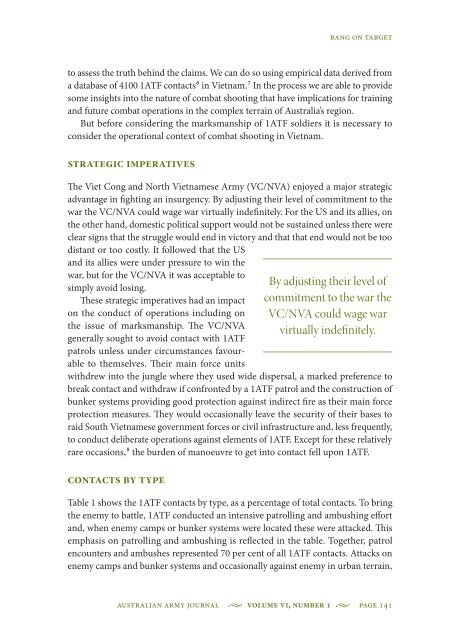Infantry Marksmanship and Combat Effectiveness ... - Australian Army
Infantry Marksmanship and Combat Effectiveness ... - Australian Army
Infantry Marksmanship and Combat Effectiveness ... - Australian Army
You also want an ePaper? Increase the reach of your titles
YUMPU automatically turns print PDFs into web optimized ePapers that Google loves.
Bang on target<br />
to assess the truth behind the claims. We can do so using empirical data derived from<br />
a database of 4100 1ATF contacts 6 in Vietnam. 7 In the process we are able to provide<br />
some insights into the nature of combat shooting that have implications for training<br />
<strong>and</strong> future combat operations in the complex terrain of Australia’s region.<br />
But before considering the marksmanship of 1ATF soldiers it is necessary to<br />
consider the operational context of combat shooting in Vietnam.<br />
Strategic imperatives<br />
The Viet Cong <strong>and</strong> North Vietnamese <strong>Army</strong> (VC/NVA) enjoyed a major strategic<br />
advantage in fighting an insurgency. By adjusting their level of commitment to the<br />
war the VC/NVA could wage war virtually indefinitely. For the US <strong>and</strong> its allies, on<br />
the other h<strong>and</strong>, domestic political support would not be sustained unless there were<br />
clear signs that the struggle would end in victory <strong>and</strong> that that end would not be too<br />
distant or too costly. It followed that the US<br />
<strong>and</strong> its allies were under pressure to win the<br />
war, but for the VC/NVA it was acceptable to<br />
simply avoid losing.<br />
These strategic imperatives had an impact<br />
on the conduct of operations including on<br />
the issue of marksmanship. The VC/NVA<br />
generally sought to avoid contact with 1ATF<br />
patrols unless under circumstances favourable<br />
to themselves. Their main force units<br />
withdrew into the jungle where they used wide dispersal, a marked preference to<br />
break contact <strong>and</strong> withdraw if confronted by a 1ATF patrol <strong>and</strong> the construction of<br />
bunker systems providing good protection against indirect fire as their main force<br />
protection measures. They would occasionally leave the security of their bases to<br />
raid South Vietnamese government forces or civil infrastructure <strong>and</strong>, less frequently,<br />
to conduct deliberate operations against elements of 1ATF. Except for these relatively<br />
rare occasions, 8 the burden of manoeuvre to get into contact fell upon 1ATF.<br />
Contacts by type<br />
By adjusting their level of<br />
commitment to the war the<br />
VC/NVA could wage war<br />
virtually indefinitely.<br />
Table 1 shows the 1ATF contacts by type, as a percentage of total contacts. To bring<br />
the enemy to battle, 1ATF conducted an intensive patrolling <strong>and</strong> ambushing effort<br />
<strong>and</strong>, when enemy camps or bunker systems were located these were attacked. This<br />
emphasis on patrolling <strong>and</strong> ambushing is reflected in the table. Together, patrol<br />
encounters <strong>and</strong> ambushes represented 70 per cent of all 1ATF contacts. Attacks on<br />
enemy camps <strong>and</strong> bunker systems <strong>and</strong> occasionally against enemy in urban terrain,<br />
<strong>Australian</strong> <strong>Army</strong> Journal • Volume VI, Number 1 • page 141

















